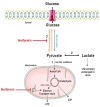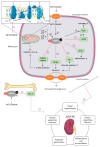Metformin: A Candidate Drug for Renal Diseases
- PMID: 30583483
- PMCID: PMC6337137
- DOI: 10.3390/ijms20010042
Metformin: A Candidate Drug for Renal Diseases
Abstract
Over the past decades metformin has been the optimal first-line treatment for type 2 diabetes mellitus (T2DM). Only in the last few years, it has become increasingly clear that metformin exerts benign pleiotropic actions beyond its prescribed use and ongoing investigations focus on a putative beneficial impact of metformin on the kidney. Both acute kidney injury (AKI) and chronic kidney disease (CKD), two major renal health issues, often result in the need for renal replacement therapy (dialysis or transplantation) with a high socio-economic impact for the patients. Unfortunately, to date, effective treatment directly targeting the kidney is lacking. Metformin has been shown to exert beneficial effects on the kidney in various clinical trials and experimental studies performed in divergent rodent models representing different types of renal diseases going from AKI to CKD. Despite growing evidence on metformin as a candidate drug for renal diseases, in-depth research is imperative to unravel the molecular signaling pathways responsible for metformin's renoprotective actions. This review will discuss the current state-of-the-art literature on clinical and preclinical data, and put forward potential cellular mechanisms and molecular pathways by which metformin ameliorates AKI/CKD.
Keywords: AMP-activated protein kinase pathway; acute kidney injury; chronic kidney disease; lactic acidosis; metformin; renoprotection; type 2 diabetes mellitus.
Conflict of interest statement
Authors declare no conflict of interest.
Figures



References
Publication types
MeSH terms
Substances
LinkOut - more resources
Full Text Sources
Medical
Miscellaneous

